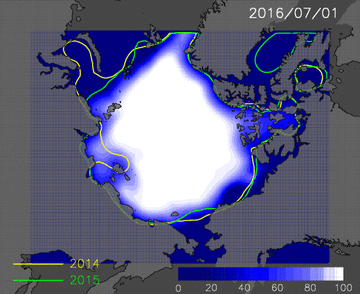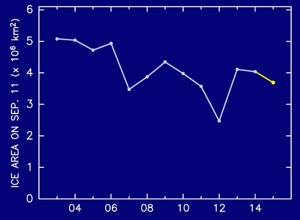Method of Prediction: Difference from the first report
Figure1:Predicted sea ice cover on September 11, 2016.
Figure 3:Animation of predicted Arctic ice extent from the July 1 to the November 1. Yellow and green lines indicates the ice edge of 2014 and 2015.
Figure 2:The interannual change of minimum extent since 2003. Value of 2015 is predicted one.
If you have any questions, please contact kimura_n@aori.u-tokyo.ac.jp
This work was partly supported by
Arctic Challenge for Sustainability Project.
This prediction used data from satellite microwave sensors AMSR-E and AMSR2. We analyzed the ice motion from December 1 up to April 30 and ice thickness on December 1, as same as the first report prediction.
In addition to the method for the first report, sea ice concentration during June 20-25 is used for the prediction. Sea ice cover in the Arctic starts retreating in May; interannual difference in the shape of ice cover becomes obvious after it. We found that sea ice concentration in June correlates strongly with that after July.
In this report we are showing the predicted ice cover by the multiple regression analysis based on the ice motion during December-April, and average sea-ice concentration during June 20-25.
-----
In this year, sea ice near the Canadian side and Atlantic side retreats rapidly compared with 2015 and 2014. On the other hand, the East Siberian Sea ice melts slowly. These features agree well with our prediction in the first report.
In this updated prediction, the ice cover in the Canadian and Atlantic sides retreats more rapidly than the first report.
1. The minimum extent in September will be about 4.6 million square kilometer,
which is a little larger than the last year.
2. The sea routes of Russian side and Canadian side will both open.
The Russian side will open around August 25, and the Canadian side except
for Canadian archipelago will open around July 10.
On the Russian side, sea ice in the Laptev Sea is expected to be thin and retreat quickly. On the other hand, sea ice in the East Siberian Sea is likely to retreat slowly. The ice retreat in the East Siberian Sea will be late compared with the last year because the area is covered by thicker ice piled up by the winter convergence of sea ice. The sea routes of the Russian side will open around the August 25, which is nearly equal to the last year.
On the Canadian side, sea ice in summer is expected to be thin and retreat more quickly than the last year. The sea routes of the Canadian side except for Canadian archipelago will open around the July 10.
Overall, the whole Arctic sea ice extent will retreat a little slowly than last year. Sea ice extent on the September 11, which is the minimal area phase of Arctic sea ice, is expected to be about 4.6 million square kilometer.
※Prediction map is also available in Arctic Data Archive System of National Institute of Polar Research.
Arctic Sea Ice Forecast 2016
Second Report:June 30, 2016
References
Kimura, N., A. Nishimura, Y. Tanaka and H. Yamaguchi, Influence of winter sea ice motion on summer ice cover in the Arctic, Polar Research, 32, 20193, 2013.
Krishfield, R. A., Proshutinsky, A., Tateyama, K., Williams, W. J., Carmack, E. C., McLaughlin, F. A., and Timmermans, M. L., Deterioration of perennial sea ice in the Beaufort Gyre from 2003 to 2012 and its impact on the oceanic freshwater cycle, J. Geophys. Res., 119, 1271-1305, doi:10.1002/2013JC008999, 2014.
---------------
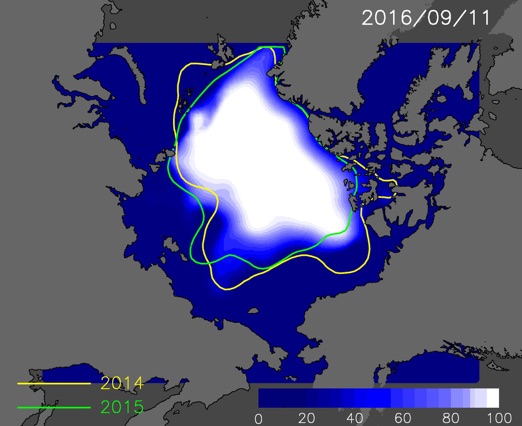
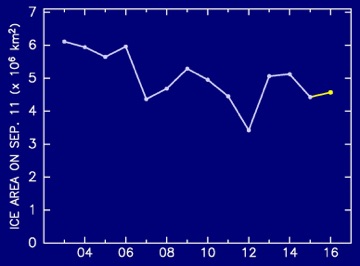

Noriaki Kimura, Hiroyasu Hasumi
Atmosphere and Ocean Research Institute, The university of Tokyo
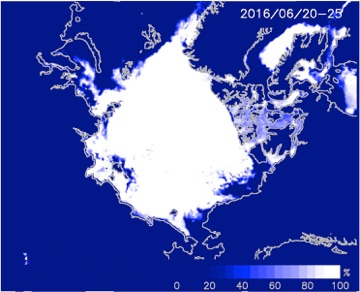
Figure 4:Mean ice concentration during June 20-25, 2016.
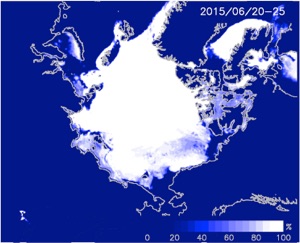
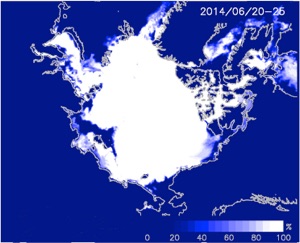
Figure 5:Mean ice concentration during June 20-25, 2015.
Figure 6:Mean ice concentration during June 20-25, 2014.
